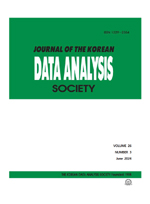베타의 변동성과 주식의 기대수익률
Volatility of Beta and Expected Stock Returns
- 한국자료분석학회
- Journal of The Korean Data Analysis Society (JKDAS)
- Vol.26 No.4
-
2024.081157 - 1174 (18 pages)
-
DOI : 10.37727/jkdas.2024.26.4.1157
- 15

본 연구는 KOSPI 시장에서 베타의 변동성이 큰 종목일수록 고평가됨으로써 미래의 주식수익률이 낮아진다는 사실을 실증적으로 제시하였다. 본 연구의 결과는 다음과 같이 요약된다. 첫째, 포트폴리오 수준의 분석 결과, 베타의 변동성이 큰 포트폴리오는 베타의 변동성이 작은 포트폴리오에 비해 상대적으로 낮은 수익률을 나타낸다. 매월 전체 종목을 베타의 변동성의 오름차순으로 10개의 포트폴리오로 나눈 후, 베타의 변동성이 가장 높은 포트폴리오를 매수하고 베타의 변동성이 가장 낮은 포트폴리오를 매도하여 구성한 무비용 헤지포트폴리오의 월평균 단순수익률 및 Fama-French 4요인 위험조정수익률(alpha)은 각각 -1.11%와 -1.45%이다. 둘째, 개별 종목 수준의 Fama-MacBeth 횡단면 회귀분석 결과, 수익률에 영향을 미치는 것으로 보고된 다수의 기업특성 변수를 통제한 이후에도 베타의 변동성은 익월의 수익률에 대해 유의한 음(-)의 설명력을 나타낸다. 이러한 결과는 베타의 변동성이 기존에 알려진 변수와는 독립적으로 수익률에 영향을 미치는 새로운 변수임을 시사한다. 셋째, 베타의 변동성이 큰 종목에 대한 고평가 현상은 주로 고유변동성이 큰 종목에 집중된다. 반면 고유변동성이 작은 종목에서는 베타의 변동성이 큰 종목에 대한 고평가 현상이 유의하게 나타나지 않는다. 이는 고유변동성이 커서 차익거래위험이 높은 종목일수록 가격오류가 발생하기 쉽다는 Stambaugh, Yu, Yuan(2015)의 주장과 부합하는 결과이다.
This paper presents the stocks with high volatility of beta (VolBeta) underperform those with low VolBeta in the Korean stock market. The main findings are summarized as follows: First, the portfolio with high VolBeta has lower return relative to the one with low VolBeta. The raw and Fama-French four factor risk-adjusted return on zero-cost portfolio buying the highest and selling lowest VolBeta deciles are -1.11% and -1.45%, respectively. Second, firm-level Fama-MacBeth cross-sectional regressions show negative and statistically significant relation between VolBeta in this month and the cross-section of future returns. The results are robust to controls for firm chracteristics reportedly affecting stock returns. Third, overpricing of the stocks with high VolBeta is mostly pronounced in the ones with high idiosyncratic volatility. On the contrary, overpricing disappears in the high VolBeta stocks with low idiosyncratic volatility. The results suggest stocks with higher arbitrage risk measured by idiosyncratic volatility are more likely to be mispriced, consistent with Stambaugh, Yu, Yuan(2015).
1. 서론
2. 선행연구
3. 자료
4. 분석결과
5. 결론
References
(0)
(0)